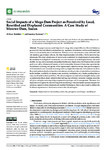Social Impacts of a Mega-Dam Project as Perceived by Local, Resettled and Displaced Communities: A Case Study of Merowe Dam, Sudan
| dc.contributor.author | Abdullah, A-N | |
| dc.contributor.author | Rahman, Sanzidur | |
| dc.date.accessioned | 2021-12-02T10:36:32Z | |
| dc.date.available | 2021-12-02T10:36:32Z | |
| dc.date.issued | 2021-09-29 | |
| dc.identifier.issn | 2227-7099 | |
| dc.identifier.issn | 2227-7099 | |
| dc.identifier.uri | http://hdl.handle.net/10026.1/18430 | |
| dc.description.abstract |
The paper assesses social impacts of a mega-dam project (Merowe Dam in Sudan) as perceived by host and affected communities (i.e., upstream, downstream, and relocated residents), which is not commonly seen in the literature. Primary survey and interviews were conducted with 300 residents, government officials, the Dam Implementation Unit (DIU), NGOs and other key informants. Five inter-related areas of impact were scrutinized: (a) displacement of communities; (b) resettlement of displaced communities in a new location; (c) technological factors; (d) social mobility factors; and (e) economic and political institutions. Results show that Merowe Dam exerted positive as well as adverse social impacts on local communities. Increase in home sizes, opportunities for children’s schooling and quality of life improvement ranked as the top three positive impacts with residents located downstream scoring relatively higher than relocated and upstream residents. Relocated residents also showed positive attitudes towards the provision of essential services (schools, health facilities, availability of running water, electricity, marketplace, etc.), thereby enabling them to enjoy and flourish in their social lives. The adverse impacts are centered on intangible factors, such as, sentimental effects closely related to their feelings, loss of history, memories, nostalgia about the old place, and grievances regarding compensation packages and its management. Therefore, it is important to recognize the need for long-term monitoring of the resettlement process and provide emotional support to those displaced and resettled. Furthermore, there is also a need to address the livelihood requirements of local communities in the affected region. | |
| dc.format.extent | 140-140 | |
| dc.language | en | |
| dc.language.iso | en | |
| dc.publisher | MDPI | |
| dc.subject | Behavioral and Social Science | |
| dc.title | Social Impacts of a Mega-Dam Project as Perceived by Local, Resettled and Displaced Communities: A Case Study of Merowe Dam, Sudan | |
| dc.type | journal-article | |
| dc.type | Journal Article | |
| plymouth.issue | 4 | |
| plymouth.volume | 9 | |
| plymouth.publication-status | Published online | |
| plymouth.journal | Economies | |
| dc.identifier.doi | 10.3390/economies9040140 | |
| plymouth.organisational-group | /Plymouth | |
| plymouth.organisational-group | /Plymouth/Faculty of Arts, Humanities and Business | |
| plymouth.organisational-group | /Plymouth/Users by role | |
| dcterms.dateAccepted | 2021-09-15 | |
| dc.rights.embargodate | 2021-12-3 | |
| dc.identifier.eissn | 2227-7099 | |
| dc.rights.embargoperiod | Not known | |
| rioxxterms.versionofrecord | 10.3390/economies9040140 | |
| rioxxterms.licenseref.uri | http://www.rioxx.net/licenses/all-rights-reserved | |
| rioxxterms.licenseref.startdate | 2021-09-29 | |
| rioxxterms.type | Journal Article/Review |


